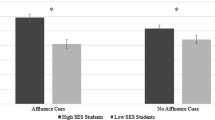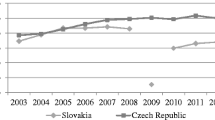Abstract
This paper examines the link between higher education and performance on the written portion of the promotional process for the rank of police sergeant. The results indicate test scores correlate positively with educational achievement. However, this effect is strongly related to the number of different study methods candidates use when preparing for the test. While a college degree appears useful in promotional competition, candidates who lack such a formal credential can mitigate its advantage by relying upon multiple study methods.
Similar content being viewed by others
References
Baro, A. L., & Burlingame, D. (1999). Law enforcement and higher education: Is there an impasse?Journal of Criminal Justice Education, 10, 57–74.
Bittner, E. (1970).The functions of police in modern society. Chevy Chase, MD: Clearinghouse for Mental Health.
Breci, M. G. (1994, January). Higher education for law enforcement: The Minnesota model.FBI Law Enforcement Bulletin, 63, 1–4.
Breci, M. G. (1997). What motivates officers to continue their education?Journal of Criminal Justice Education, 8, 51–60.
Buckley, L. B., & Petrunik, M. (1996). Socio-demographic factors, reference groups, and the career orientations, career aspirations and career satisfaction of Canadian police officers.American Journal of Police, 14(2), 107–148.
Buckley, L. B., McGinnis, J. H., & Petrunik, M. (1993). Police perceptions of education as an entitlement to promotion: An equity theory perspective.American Journal of Police, 12(2), 77–100.
Buracker, C. D. (1979). The educated police officer: Asset or liability?The Police Chief, 46(9), 90–94.
Carlan, P. E. (1999). Occupational outcomes of criminal justice graduates: Is the master’s degree a wise investment?Journal of Criminal Justice Education, 10, 39–56.
Carter, D. L., & Sapp, A. D. (1990a).Higher education and minorities in law enforcement: A policy perspective. Paper presented at the annual meeting of the Academy of Criminal Justice Sciences, Denver, CO.
Carter, D. L., & Sapp, A. D. (1990b). The evolution of higher education in law enforcement: Preliminary findings from a national study.Journal of Criminal Justice Education, 1, 601–627.
Carter, D. L., Sapp, A. D., & Stephens, D. W. (1988). Higher education as a bona fide occupational qualification (BFOQ) for police: A blueprint.American Journal of Police, 7(2), 1–27.
Carter, D. L., Sapp, A. D., & Stephens, D. W. (1989).The state of police education: Policy direction for the 21st century. Washington, DC: Police Executive Research Forum.
Cohn, E., & Hughes, W. W., Jr. (1994). A benefit-cost analysis of investment in college education in the United States: 1969–1985.Economics of Education Review, 13(2), 109–123.
Dale, A. (1994). Professionalism and the police.The Police Journal, 67(3), 209–218.
Dantzker, M. L. (1993). An issue for policing: educational level and job satisfaction.American Journal of Police, 12(2), 101–118.
Dantzker, M. L. (1998). Police education and job satisfaction: Educational incentives and recruit educational requirements.Police Forum, 8(3), 1–3.
Eastman, G. D., & McCain, J. A. (1981). Education, professionalism, and law enforcement in historical perspective.Journal of Police Science and Administration, 9, 119–130.
Fischer, R. J. (1981). Is education really an alternative?Journal of Police Science and Administration, 9, 313–316.
Fischer, R. J., Golden, K. M., & Heininger, B. L. (1985). Issues in higher education for law enforcement officers: An Illinois study.Journal of Criminal Justice, 13, 329–338.
Fyfe, J. J., Greene, J. R., Walsh, W. F., Wilson, O. W., & McLaren, R. C. (1997).Police administration (5th ed.). New York: McGraw-Hill.
Gaines, L. K., VanTubergen, N., & Pavia, M. A. (1984). Police officer perceptions of promotion as a source of motivation.Journal of Criminal Justice, 12, 265–275.
Gammage, A. (1963).Police training in the United States. Springfield, IL: Charles C. Thomas.
Hawley, T. J. (1998). The collegiate shield: Was the movement purely academic?Police Quarterly, 1(3), 35–59.
Molder, E. R. (1991).Police personnel practices: Education, participation and scheduling. Washington, DC: ICMA.
National Advisory Commission on Criminal Justice Standards and Goals. (1973).Task force report: The police. Washington, DC: U.S. Government Printing Office.
National Advisory Commission on Higher Education for Police Officers. (1978).The Sherman report. San Francisco: Jossey Bass.
National Advisory Commission on Law Observance and Enforcement. (1931).Report on the police. Washington, DC: U.S. Government Printing Office.
Palumbo, B. J. (1995).Academic professionalism in law enforcement. New York: Garland.
Patterson, D. E. (1991). College educated police officers: Some impacts on the internal organization.Law and Order, 59(11), 68–71.
President’s Commission on Law Enforcement and the Administration of Justice. (1967).Task force report: The police. Washington, DC: U.S. Government Printing Office.
Rodriguez, M. (1995). Increasing the importance of higher education in police human resource development programs.C.J.: The Americas, 8(2), 6–9.
Schrink, J. L., Sudipto, R., & Ransburg, J. (1999). Perceptions of alumni concerning their level of preparation for criminal justice careers: A pilot study.Journal of Criminal Justice Education, 10, 75–86.
Seltzer, R., Alone, S., & Howard, G. (1996). Police satisfaction with their jobs: Arresting officers in the District of Columbia.Police Studies, 19(4), 25–37.
Sherman, L. W. (1978).Quality of police education: A critical review with recommendations for improving programs of higher education. San Francisco: Jossey-Bass.
Tafoya, W. L. (1990, January). The future of policing.FBI Law Enforcement Bulletin, 59, 13–17.
Thomas, S. (1963). The Baruch school’s experience.Police yearbook. Washington, DC: International Association of Chiefs of Police.
Van Meter, C. W. (1982).Perceptions of selected criminal justice graduates, faculty and police chiefs on the impact of education on job performance, promotion and job satisfaction in 1980. Unpublished doctoral dissertation, Southern Illinois University, Carbondale, IL.
Varricchio, D. (1998, April). Continuing education: Expanding opportunities for officers.FBI Law Enforcement Bulletin, 67, 10–14.
Author information
Authors and Affiliations
Corresponding author
Rights and permissions
About this article
Cite this article
Whetstone, T.S. Getting stripes: Educational achievement and study strategies used by sergeant promotional candidates. Am J Crim Just 24, 247–257 (2000). https://doi.org/10.1007/BF02887596
Issue Date:
DOI: https://doi.org/10.1007/BF02887596




